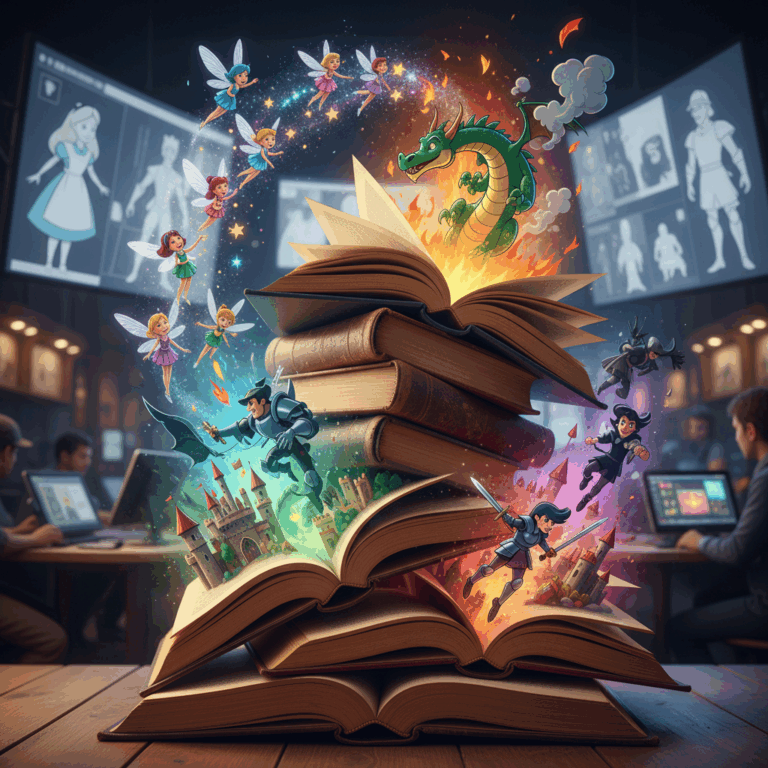Interaction between literature and animation in childhood and youth
The interaction between literature and animation It has enriched the world of children and young people, facilitating the discovery of great stories for new generations. Both disciplines are integrated to offer memorable and visually appealing narratives.
The Books provide rich worlds and iconic characters that inspire animation creators to develop stories that capture the literary essence while innovating in their representation.
Importance of books as a source for animation
The books are essential sources for animationby offering deep stories and narrative universes that allow animators to explore diverse visual and narrative techniques.
Adapting a book involves understanding and respecting its content, translating it so that it connects emotionally with the audience through an engaging and meaningful audiovisual language.
Furthermore, literary works fill the animated medium with cultural richness and educational valuefacilitating access to classic texts and promoting a love of reading.
Classic examples adapted to the animated format
Classic works such as Alice in Wonderland and Anne of Green Gables They have been reinterpreted in animation with respect for the original essence and a fresh approach for children and young people.
Other emblematic examples include Don Quijote of La Mancha and The Three Musketeers, which have inspired creative adaptations, transforming iconic characters into unforgettable animated figures.
Interesting fact
The series D'Artacan and the Three Musketeers It adapts literary classics with an original twist: the characters are dogs, a strategy that combines humor and fidelity to the narrative.
Animated adaptations of complex and universal literary works
Animated adaptations of complex literary works allow for addressing profound and universal themes, facilitating their understanding through visual and symbolic language.
This combination enhances the reach of literature, enabling diverse audiences to connect with highly relevant political and cultural messages.
Works with political and symbolic content
Works such as Animal Farm They use animation to represent political and symbolic messages, bringing critical themes closer to a young audience without losing their essence.
Animation allows complex concepts to be translated into visual metaphors, facilitating reflection on power, oppression, and freedom in an accessible and captivating way.
Furthermore, the use of visual symbols in these adaptations amplifies the impact of the original message and enriches the viewer's interpretive experience.
Analysis of in-depth themes in animation
Animation, in adaptations of complex works, can explore profound themes such as fear, war, and identity, combining childlike and adult sensibilities.
Examples such as When the Wind Blows They demonstrate how the emotional impact of historical events can be addressed through visual techniques that communicate beyond words.
This approach allows a moving and educational message to be conveyed, using animation to awaken empathy and social awareness in diverse audiences.
Visual and technical innovations in recent adaptations
Contemporary adaptations stand out for incorporating innovative techniques such as stop-motion and experimental visual styles that enrich the original narrative.
Works such as Coraline and The Fantastic Mr. Fox They use these techniques to create unique atmospheres that delve into the complexity and richness of the literary text.
These innovations ensure that the adaptations are not only faithful to the original works, but also spark the visual and emotional interest of modern audiences with captivating artistic proposals.
Stylistic and narrative choices in animated adaptations
Adapting literary texts into animation requires a careful approach to preserve the original spirit while exploring new visual and narrative forms.
Creators must decide which narrative elements are maintained, transformed, or emphasized, always seeking an emotional connection with the current audience.
Methodology for adapting literary texts to animation
The process begins with an in-depth analysis of the original text, identifying its central themes, characters, and tone to ensure a faithful interpretation in the animation.
Next, the stylistic possibilities that best express the literary essence are evaluated, considering animation techniques that enhance the visual narrative.
Decisions are made about the narrative structure, adapting the rhythm and details to work in an audiovisual format, while maintaining coherence and emotion.
This methodology allows the adaptation to be not only a literal translation, but a creative reinterpretation that enriches and expands the impact of the original work.
Recognition and cultural value of animated adaptations
Animated adaptations of literary works have achieved global recognition, establishing themselves as key pieces in popular culture and promoting the dissemination of literature.
This phenomenon contributes to preserving and strengthening cultural heritage, bringing classic stories closer to modern audiences through an accessible and attractive visual language.
Impact of Disney and other studios on popular culture
Disney has been instrumental in popularizing animated adaptations, transforming stories and novels into unforgettable productions that are part of the collective memory.
Studios like Ghibli and Laika also contribute original approaches, enriching animation with artistic interpretations that respect and renew literary sources.
These companies influence popular culture by creating animated versions that transcend generations, generating an emotional bond between the public and literature.
Animation as a vehicle to revitalize literary heritage
Animation is an effective means of revitalizing literary heritage, as it updates and reinterprets classic stories, making their message endure over time.
Animation promotes interest in reading, making complex or old texts more accessible and attractive to new audiences.
Thus, animation not only preserves literature, but also transforms it into a dynamic and relevant cultural experience for different generations.






